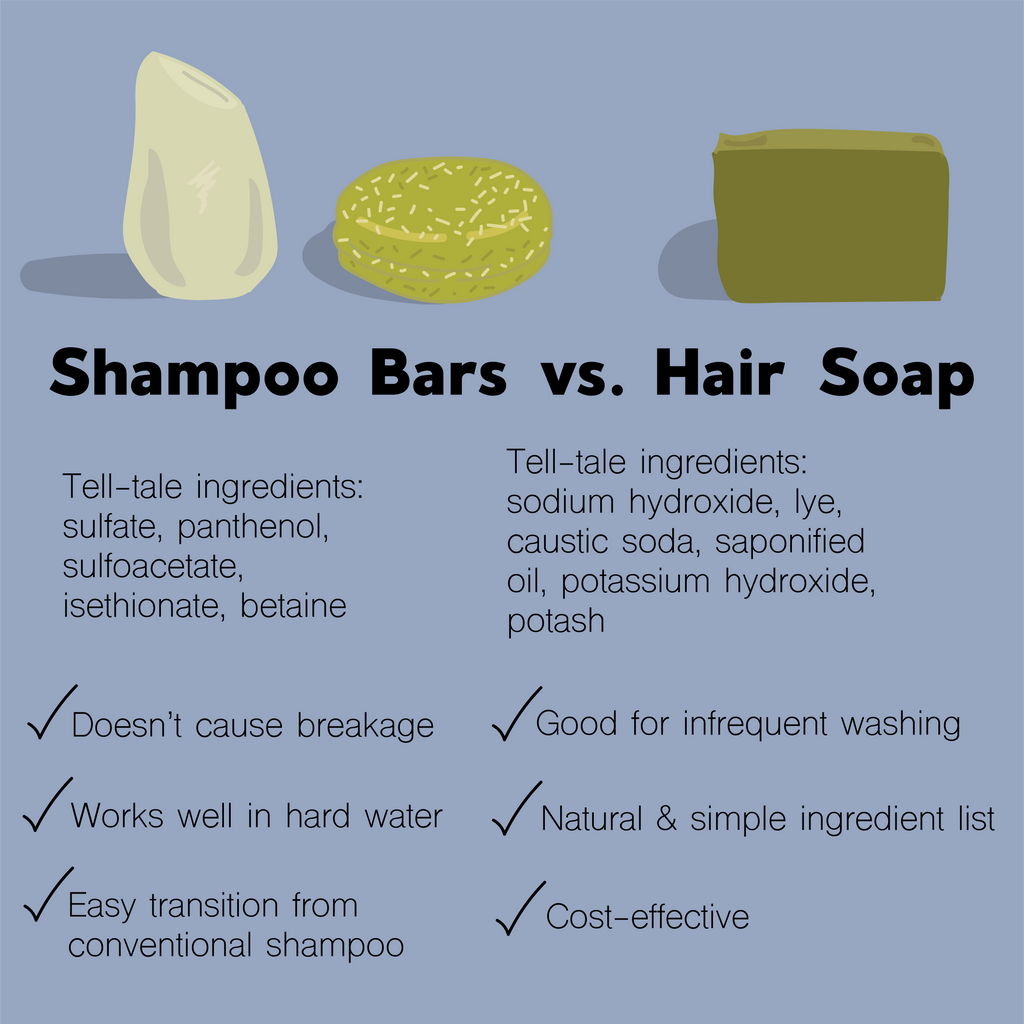You’ve spent your whole life buying shampoo from the drug store around the corner and picking the brand that promises all those hair features you’ve always wanted. Now you’re ready to ditch the plastic bottle, and you want to make sure that whatever swap you’re choosing leaves your hair clean and healthy. The problem is that many zero-waste shampoos aren’t promoted based on their fitness for your specific hair situation. They’re only promoted as “package-free” because when you’re charged with taking care of the planet you can’t also worry about taking care of your hair, right?? No way! You can and should have both. There’s so much to consider when choosing a package-free shampoo. We want to help break it down for you so that you can have a better chance of getting it right on the first try.
Soap vs. Shampoo
Many of the "shampoo bars" you're encountering on Instagram and Pinterest are actually soap. How can you tell the difference? Often a hair soap bar will look just like any bar of soap. It’s smooth and has a waxy-looking texture. A shampoo bar, on the other hand, often has a matte texture and can look almost powdery. In liquid form, the textures of soap and shampoo may be similar. You can tell the difference by reading the ingredient label. If a product contains sodium hydroxide, potassium hydroxide, lye, caustic soda, potash, or anything “saponified,” it’s soap.
How They Work
The reason our hair gets dirty is because our scalps produce sebum, an oil that coats and protects our hair. Sebum attracts dirt and repels water, so washing our hair with water alone would be ineffective. Both shampoo and soap contain hydrophilic and hydrophobic components that can combine with water and oil respectively. These allow the oil in our hair to bind with water and be rinsed away.
The Downsides
Shampoos often contain detergents that are known for stripping our scalps of oils to the extent that our scalps begin to over-compensate. Many of us need to wash our hair very frequently – as often as every day – to keep up with this overcharged sebum production. Some shampoos contain especially harsh ingredients (such as Sodium Laurel Sulfate), that strip our scalp of healthy bacteria. This can lead to hair loss and rashes. The chemicals in shampoo can also leave a buildup in our hair that makes the transition away from shampoo particularly arduous. Well gee, shampoo sounds pretty awful, right? Let's talk about soap.
Soap is made with lye (or caustic soda, potash, sodium hydroxide, potassium hydroxide, …) which is very alkaline (pH level 13 – 14). It’s for this reason that soap also has a relatively high pH of around 9 or 10. Our scalp, on the other hand, hovers at around 4.5 – 5.5. So putting soap on our scalp is a bit of a shock to our hair pH-wise. When our hair and scalp are too alkaline, the cuticles of our hair open, leaving our hair susceptible to breakage. Curly hair is especially vulnerable since the cuticles of curly hair are already partially open. Alkaline products can also cause problems for our scalps, including eczema, fungi, and itchiness. These issues can be mitigated by rinsing soap-washed hair with an acidic product like apple cider vinegar.
Soap is also problematic for those of us with hard water. If you’re in the U.S., you can find out if you have hard water on this website. When soap is used with hard water, minerals like calcium and magnesium combine with soap to form soap scum. This can cause a buildup in hair that leaves it looking dull and dirty.
We realize this is kind of a laundry list of negatives. The idea is that you know what you want your hair cleanser to do. So when you're choosing between hair soap and shampoo, you can ask yourself, what do you want it not to do?
Making the Choice
Ultimately, the option that works best for you will depend on a combination of factors. Here is a summary of some of the upsides of each.

Within the broader categories of soap versus shampoo, there are lots of subcategories that will address your specific hair concerns (such as moisture, volume, dandruff, etc.). We’ve selected a variety of products to stock in our store to address as many of these concerns as possible. Read our Low Waste Hair Care Guide for a list of products made with your hair type in mind. And check out our selection here!
References: 1| How Shampoo Works - Thought Co., 2| How to Balance pH in Hair Naturally - wikiHow, 3| Water Hardness and Alkilinity - USGS, 4| Why Hard Water Doesn't Get Along With Soap - Baird & Crockett



